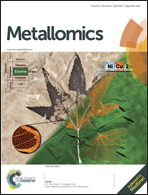Selective anticancer copper(ii)-mixed ligand complexes: targeting of ROS and proteasomes†
Abstract
Copper compounds can be alternatives to platinum-based anticancer drugs. This study investigated the effects of a series of ternary copper(II) complexes, [Cu(phen)(aa)(H2O)]NO3·xH2O 1–4 (phen = 1,10-phenanthroline; aa = gly (1), DL-ala (2), sar (3), C-dmg (4)), on metastatic and cisplatin-resistant MDA-MB-231 breast cancer cells and MCF10A non-cancerous breast cells, and some aspects of the mechanisms. These complexes were distinctively more antiproliferative towards and induced greater apoptotic cell death in MDA-MB-231 than in MCF10A cells. 2 and 4 could induce cell cycle arrest only in cancer cells. Further evidence from DCFH-DA assay showed higher induction of reactive oxygen species (ROS) in treated cancer cells but minimal ROS increase in normal cells. DNA double-strand breaks, via a γ-H2AX assay, were only detected in cancer cells treated with 5 μM of the complexes. These complexes poorly inhibited chymotrypsin-like activity in the 20S rabbit proteasome while they did not inhibit the three proteolytic sites of MDA-MB-231 cells at 10 μM. However, the complexes could inhibit degradation of ubiquinated proteins of MDA-MB-231 cells. In addition, compound 4 was found to be effective against cervical (Hela), ovarian (SKOV3), lung (A549, PC9), NPC (Hone1, HK1, C666-1), breast (MCF7, T47D), lymphoma and leukemia (Nalmawa, HL60) and colorectal (SW480, SW48, HCT118) cancer cell lines with IC50 values (24 h) in the 1.7–19.0 μM range. Single dose NCI60 screening of 4 showed the complex to be highly cytotoxic to most cancer cell types and more effective than cisplatin.


 Please wait while we load your content...
Please wait while we load your content...